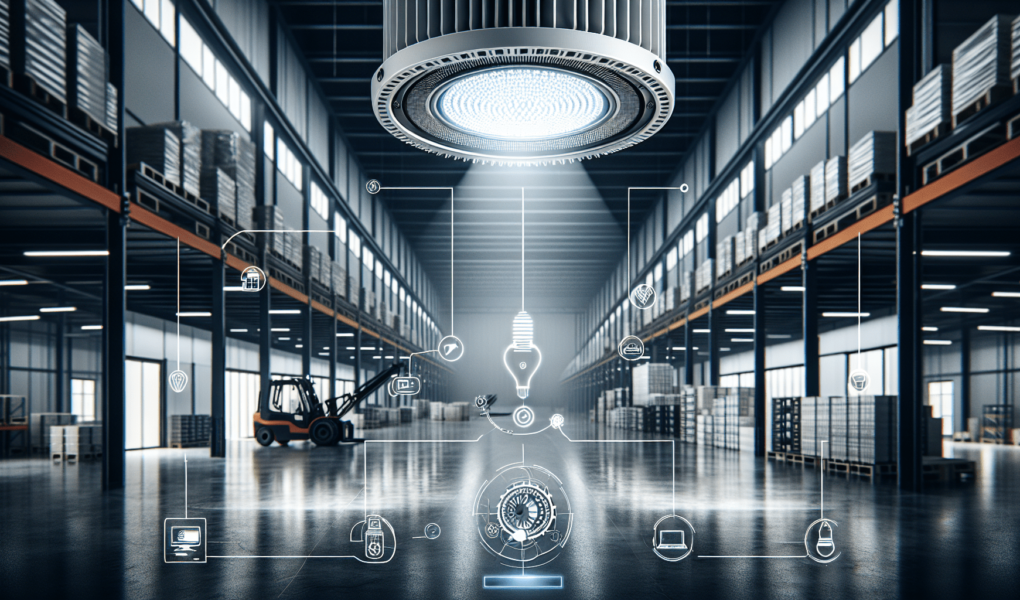Welcome to the world of innovative approaches in industrial lighting design! In this article, you will explore the latest trends and techniques being used to create efficient and effective lighting solutions for industrial spaces. From energy-efficient LED technology to advanced lighting controls, you will discover how designers are revolutionizing the way we illuminate factories, warehouses, and manufacturing facilities. Get ready to see how these innovative approaches are not only enhancing productivity and safety but also transforming the aesthetics of industrial spaces. Let’s light up your world with creativity and ingenuity in industrial lighting design. Have you ever wondered how industrial lighting design impacts productivity and safety in the workplace? Well, you’re in the right place! Let’s explore some innovative approaches in industrial lighting design that can enhance the efficiency and well-being of workers in industrial settings.

Importance of Industrial Lighting Design
Industrial lighting design plays a crucial role in ensuring the productivity, safety, and comfort of workers in industrial facilities. Proper lighting not only helps workers see clearly and perform tasks efficiently but also contributes to their overall well-being by reducing eye strain and fatigue. Inadequate lighting can lead to errors, accidents, and health issues, ultimately affecting the bottom line of a business.
Impact on Productivity
Good lighting in industrial settings is essential for maximizing productivity. Proper illumination can improve visibility, reduce errors, and enhance concentration, leading to increased efficiency and output. Workers are able to work faster and more accurately when they can see clearly, resulting in higher productivity levels.
Impact on Safety
Safety is a top priority in industrial environments, and proper lighting is critical in ensuring a safe work environment. Adequate illumination can help prevent accidents, identify hazards, and promote visibility in dimly lit areas. Well-lit workspaces reduce the risk of slips, trips, and falls, making it easier for workers to navigate their surroundings and operate machinery safely.

Innovative Lighting Technologies
Advancements in lighting technologies have revolutionized industrial lighting design, offering more efficient, cost-effective, and environmentally friendly solutions. Let’s explore some innovative lighting technologies that are transforming industrial workplaces.
LED Lighting
LED (Light Emitting Diode) lighting has become increasingly popular in industrial settings due to its energy efficiency, long lifespan, and high brightness. LED fixtures produce bright, focused light that can improve visibility and reduce energy consumption compared to traditional lighting sources. These fixtures are also durable, eco-friendly, and require minimal maintenance, making them a cost-effective lighting solution for industrial applications.
Smart Lighting Systems
Smart lighting systems utilize automation, sensors, and controls to adjust lighting levels based on occupancy, natural light, and time of day. These systems can optimize energy usage, reduce operating costs, and enhance worker comfort by providing the right amount of light when and where it’s needed. Smart lighting systems can be programmed to dim or brighten lights in specific areas, schedule lighting based on work shifts, and monitor energy usage in real-time, allowing businesses to make informed decisions regarding their lighting infrastructure.
Daylight Harvesting
Daylight harvesting is a sustainable lighting strategy that leverages natural light to illuminate indoor spaces and reduce the need for artificial lighting. By incorporating windows, skylights, and light shelves into industrial buildings, businesses can maximize natural light penetration, minimize glare, and create a more comfortable work environment. Daylight harvesting systems often include sensors and controls that adjust artificial lighting levels based on available natural light, ensuring consistent illumination throughout the day while maximizing energy savings.
Human-centric Lighting
Human-centric lighting focuses on the well-being and productivity of individuals by simulating natural light patterns to synchronize with the body’s circadian rhythm. By adjusting the color temperature and intensity of artificial lighting throughout the day, human-centric lighting can promote alertness, focus, and relaxation, helping workers maintain a healthy sleep-wake cycle and overall well-being. Industrial facilities can benefit from human-centric lighting by enhancing worker performance, reducing fatigue, and improving mood and productivity levels.

Design Considerations for Industrial Lighting
When designing industrial lighting systems, several factors must be taken into consideration to ensure optimal performance, energy efficiency, and worker comfort. Let’s explore some key design considerations for industrial lighting that can help businesses create well-lit, safe, and productive workspaces.
Task Lighting
Task lighting is essential for illuminating work areas, machinery, and equipment where detailed tasks are performed. LED task lights, adjustable fixtures, and task-specific lighting solutions can provide focused, glare-free illumination that enhances visibility and accuracy. By strategically placing task lights where they are needed most, businesses can improve worker efficiency, reduce errors, and create a safer work environment.
High Bay Lighting
High bay lighting is commonly used in warehouses, manufacturing facilities, and industrial buildings with high ceilings. These fixtures are designed to deliver bright, uniform light distribution over a large area, making them ideal for illuminating open spaces and high racks. High bay fixtures are available in various wattages, color temperatures, and beam angles to meet the specific lighting needs of different industrial applications. By selecting the right high bay fixtures and positioning them correctly, businesses can achieve optimal lighting levels, reduce energy costs, and enhance worker visibility and safety.
Emergency Lighting
Emergency lighting is a critical component of industrial lighting design that ensures visibility and safety during power outages, fires, or other emergencies. Emergency lighting systems include exit signs, emergency lights, and backup fixtures that are powered by batteries or generators to provide temporary illumination until normal power is restored. Properly designed emergency lighting systems should meet local building codes and standards, be regularly tested and maintained, and have clear visibility to guide workers to safety in emergency situations.
Energy Efficiency
Energy efficiency is a key consideration in industrial lighting design, as lighting can account for a significant portion of energy consumption in industrial facilities. Implementing energy-efficient lighting technologies, such as LED fixtures, smart lighting systems, and daylight harvesting strategies, can help reduce energy costs, minimize environmental impact, and improve overall sustainability. Businesses can also optimize energy savings by using occupancy sensors, timers, and controls to regulate lighting levels, switch off lights in unoccupied areas, and adjust illumination based on specific lighting requirements.
Maintenance and Upkeep
Regular maintenance and upkeep of industrial lighting systems are essential to ensure optimal performance, longevity, and safety. Routine inspections, cleaning, and replacement of lamps, fixtures, and controls can prevent malfunctions, flickering, or dimming of lights, and extend the lifespan of lighting equipment. Businesses should establish a maintenance schedule, conduct periodic checks, and address any issues promptly to keep their lighting systems operating efficiently and effectively.

Conclusion
In summary, industrial lighting design plays a vital role in enhancing productivity, safety, and well-being in industrial workplaces. By adopting innovative lighting technologies, considering key design factors, and prioritizing energy efficiency and maintenance, businesses can create well-lit, safe, and productive environments for their workers. Investing in quality lighting solutions can improve visibility, reduce accidents, and optimize energy usage, ultimately benefiting the bottom line of a business. So, whether you’re upgrading your existing lighting system or planning a new industrial facility, remember that proper lighting design is key to unlocking the full potential of your workforce and ensuring a bright future for your business.
Remember, the right lighting can make all the difference in creating a safe, productive, and enjoyable work environment for you and your colleagues. So, take the time to explore innovative lighting solutions and design considerations that can transform your industrial workplace into a brighter, better, and more efficient space. Your eyes, your productivity, and your well-being will thank you for it!



